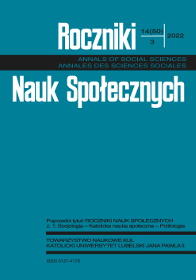Polish Public on the Ukrainian Refugees in the First Month of the Russian-Ukrainian War in the “Polityka” and “Gość Niedzielny” Weeklies: Research Report
Research Statement
Abstract
Abstract. 30 days after Russia’s attack on Ukraine 2.5 million Ukrainian refugees have crossed the border with Poland. The purpose of this article was to conduct a research on how two Polish weeklies with the highest circulation – “Polityka” and “Gość Niedzielny” – had presented the Polish public’s reaction vis-à-vis the Ukrainian refugees in the first month of the war. Focus of the analysis was also the interdependence between the articles, and initiatives undertaken by the government and by the Church aimed at helping the refugees. The quantitative and qualitative methods of analysis were applied in this article. The method of analyzing the context of the press discourse was also used. For the sake of the research a categorizing key and a questionnaire were prepared. Articles published during the research period show the above mentioned issue was not covered equally extensive, although the number of articles was similar. The articles published in both weeklies present a different picture of the Polish society that corresponds with their respective political affiliation.
References
Babbie E. (2013), Podstawy badań społecznych, Warszawa: Wydawnictwo Naukowe PWN.
Cinalli M. (2021) i in. [H.-J. Trenz, V. Brändle, O. Eisele, Ch. Lahusen], Solidarity in the Media and Public Contention over Refugees in Europe, London and New York: Routledge.
Díez Bosch M., Micó Sanz J.l., Sabaté Gauxachs A. (2019), Letting Diasporic Voices be Heard. Refugees and Migrants in European Media, The Ecumenical Review 71, nr 1-2, s. 110-132.
Emmer M., Kunst M., Richter C. (2020), Information Seeking and Communication During Forced Migration: An Empirical Analysis of Refugees’ Digital Media use and its Effects on their Perceptions of Germany as their Target Country, “Global Media and Communication”, 16, nr 2, s. 167-186.
Gorin V. (2018), Journalistic Practices in the Representation of Europe’s 2014-2016 Migrant and Refugee Crisis, “Journal of Applied Journalism & Media Studies”, 7, nr 1, s. 3-14.
Lisowska-Magdziarz M. (2004), Analiza zawartości mediów: przewodnik dla studentów wersja 1.1, Kraków: Wydział Zarządzania i Komunikacji Społecznej Uniwersytetu Jagiellońskiego, s. 23-65.
Moen-Larsen N. (2020), Brothers and Barbarians: Discursive Constructions of ‘Refugees’ in Russian Media, Acta Sociologica, 63, nr 2, s. 226-241.
Pisarek W. (1983), Analiza zawartości prasy, Kraków: Ośrodek Badań Prasoznawczych.
Průchová Hrůzová A. (2021), Article What is the Image of Refugees in Central European Media?, European Journal of Cultural Studies, 24, nr 1, s. 240-258.
Rehejeh F. (2020), To Come or Not to Come: A Content Analysis of the Refugee Crisis in The Romanian Mass Media, “Saeculum”, 5, nr 2, s. 159-173.
Sajir Z., Aouragh M. (2019), Solidarity, Social Media, and the “Refugee Crisis”: Engagement Beyond Affect, International Journal of Communication, 13, s. 550-577.
Szymańska A., Lisowska-Magdziarz M., Hess A. (red.) (2018), Metody badań medioznawczych i ich zastosowanie, Kraków: IDMIKS, s. 113-166.
Copyright (c) 2022 Roczniki Nauk Społecznych

This work is licensed under a Creative Commons Attribution-NonCommercial-NoDerivatives 4.0 International License.


